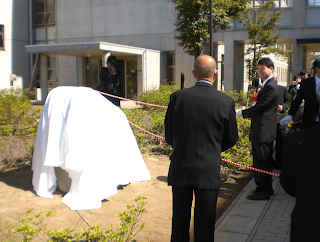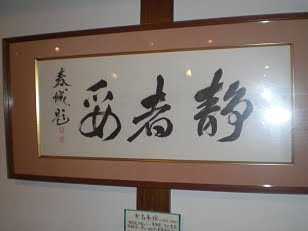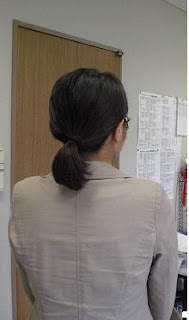Yesterday, my son and I went to Ijimino in Shibata City, which is where the Ichishima family established the original family domicile in Niigata Prefecture. We went there to learn more about one of the great members of our extended family, Kenkichi Ichishima (who went by the pen name of Shunjo).
First, we visited his grave in the Ijimino Cemetery. His tomb, which is right next to our family tomb, was repaired by Waseda University last year. Earlier, in a special ceremony in Shibata City, Waseda's president delivered a speech in commemoration of the one-hundred fiftieth anniversary of Shunjo Ichishima's birth.
Photo: Kenkichi Ichishima (1860-1944)
A teacher for only a short time, Ichishima later worked as Library Director and assisted with the university's management. He played a major role in fund-raising for the university's expansion. He also served as director of the Dainippon Bunmei Kyōkai (Japan Civilization Society) and chairman of the Japan Library Association. (Retrieved from Waseda University’s home page)
Next, my son, a Waseda University student, and I went to Ichishima Tei or the Ichishima Residence Museum, to see a special exhibition about Kenkichi Ichishima’s accomplishments that featured a newly erected statue in his honor. A duplicate statue was also erected on the Waseda campus.
According to Waseda University’s website, the men that congregated around Shigenobu Ōkuma, the founder of the university, and assisted him in both his political ambitions and in the founding of Waseda University, included “a galaxy of talented individuals.” Amongst them were the enthusiastic young students of Azusa Ono's Ōtōkai (The Gull Society), who graduated from Tokyo Imperial University (now called The University of Tokyo). With Sanae Takata as the leader, the group was sometimes called the “University Group of Seven.” Ichishima also belonged to the group, but he quit school and rushed to Ōkuma's aid when Ōkuma left public office in 1881.
From then until Ōkuma's death in 1922 (Taishō 11), Ichishima spent over forty years as one of Ōkuma's attendants. During that time, Kenkichi Ichishima (who went by the pen name of Shunjō) was a prolific writer, and he left behind an extensive catalog of essays, records, and notes. He was something of a chronicler of Ōkuma and Waseda University.
Ichishima was born in 1860 (Manen 1), the same year that Chief Minister Ii Naosuke was assassinated in the Sakuradamon Incident. By strange coincidence, he died in 1944 (Shōwa 19) at the age of 85, the same age that Ōkuma died.
Ichishima's family were wealthy landowners from the Echigo Province (located in current-day Niigata Prefecture). When Issei Maeshima was appointed as a commissioner after the Meiji Restoration, he used the spacious Ichishima home as his official residence, and is said to have doted on Ichishima, who, after studying in Suibara, Niigata, moved to Tokyo and entered Tokyo University. There he became friends with Sanae Takata, Shōyō Tsubouchi, Kenkichi Okayama, Ichirō Yamada, Kinosuke Yamada, and Katsutaka Sunakawa. He joined the Ōtōkai (Gull Society), supported Ōkuma in establishing the Rikken Kaishintō (Constitutional Reform Party), and later devoted himself to the founding of Tokyo Senmon Gakkō (College) and the development of Waseda University.
Ichishima had an especially close relationship with Takata. Judging from the roles they played, their relationship was like that of the sun and moon.
Takata served as Waseda's president, as a politician who served in the Diet in the Kizokuin (House of Peers: the upper house of the Imperial Diet under the Constitution of the Empire of Japan, which was in effect from February 11, 1889 to May 3, 1947), and as Minister of Education. Ichishima also served in the Diet as an elected member from Niigata Prefecture, but his career was cut short due to illness.
Thereafter, he supported Takata as Executive Director, Auditor, and Library Director of Waseda University. He also assisted with fund-raising and expanding the Waseda University Library.
During this period, he always walked in Takata's shadow, and in the general election during the second Ōkuma cabinet, served as Ōkuma's campaign director. When Takata was sick or traveling abroad, Ichishima took care of all of his duties. He was flexible and responsive—a literary man, uninterested in fame or fortune. During the so-called “Waseda Troubles,” Ichishima faced down attacks as head of the Takata faction. After Ōkuma's death, he handled all the planning and organizing for the funeral.
(From “Episode—Ōkuma Shigenobu (Episodes in the Life of Shigenobu Ōkuma)”)
Retrieved from http://www.waseda.jp/eng/okuma/people/people106.html



















































